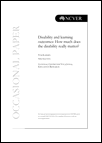Description
On the whole, educational achievements and outcomes from vocational education and training (VET) are relatively poor for students reporting a disability. This paper sought to isolate the direct effect of being a member of a particular disability group. It found that the direct effect of the disability differs between groups, and is highest for those with a mental illness, a medical condition or a physical disability.Summary
About the research
In 2005, the National Centre for Vocational Education Research (NCVER) produced a statistical compendium examining vocational education and training (VET) students with a disability as a whole group; it also compared different disability groups, focusing on their participation levels, achievements and outcomes from VET in 2003 (Cavallaro et al. 2005).
The report found that, on the whole, educational achievements and outcomes from VET are relatively poor for students reporting a disability, but there is considerable variability between types of disability.
In addition, educational achievement prior to commencing VET was found to have some bearing on students' results in VET. Generally, students reporting a disability in VET have lower prior education and poorer outcomes from VET than all other VET students. This implies that the poor educational performance of students reporting a disability may be due to their educationally disadvantaged position rather than their disability.
This paper, Disability and leaning outcomes: How much does the disability really matter? by Tom Karmel and Nhi Nguyen, seeks to highlight the direct effect of the disability by controlling for the background characteristics (notably educational background, but also age, level of study and field of study) in a simple statistical model.
Key messages
- The study finds that with disabilities such as hearing/deaf, intellectual, acquired brain impairment and vision, the actual disability explains little, once we take into account other student characteristics such as age, sex, educational background and course studied.
- By contrast, both student characteristics and the disability itself directly impact on the low completion rates of those with a physical or mental illness or a medical condition.
Overall, the significant point to emerge is that it is not helpful to treat students with a disability as one group. The different disability groups have students with different background characteristics, and the direct effect of the disability on academic performance differs between groups.
Tom Karmel
Managing Director, NCVER
